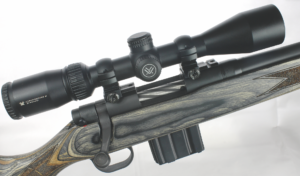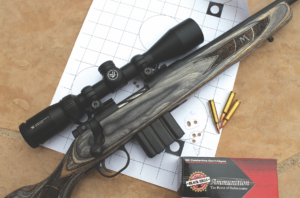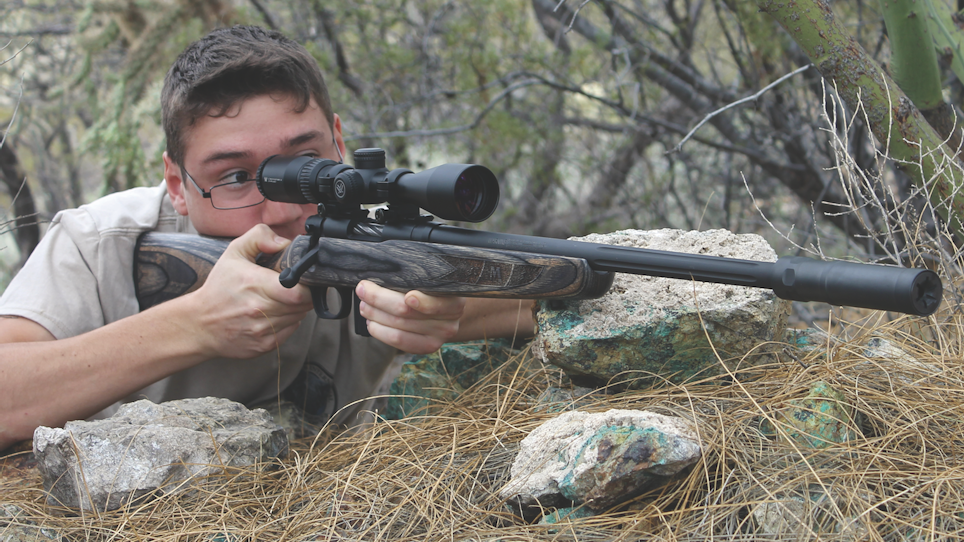The barrel of the Mossberg MVP Predator Combo offers many features and is threaded 1/2-28. Silencer Shop recommended a Griffin Armament Optimus Micro suppressor. (Photo: Scott Mayer)
It wasn’t long after Modern Sporting Rifles (MSRs) became incredibly popular that predator hunters began clamoring for bolt-action rifles that fed from AR-style magazines. Not only were the magazines abundant and in a variety of capacities, but also for a given price it’s easier to make a more accurate bolt-action rifle than it is a semi-auto.
But repeatedly, we in the gun industry were told that mechanically you simply couldn’t mass produce bolt-actions that feed from MSR magazines. Various reasons given by engineers include the magazine catch is on the side and the cartridges sitting too low for the bold face to pick them up.
But demand persisted — not only for bolt-actions that fed from AR-15-type magazines, but also for more powerful rifles that fed from M1A/M14 or AR-10 magazines. Mossberg heard the call and responded.
“We introduced the MVP in 2011,” said Linda Powell, Mossberg’s Director of Media Relations. “The platform delivered an engineering breakthrough; a bolt-action that could accept and reliably feed from [5.56mm (.223 Rem.)] AR-style magazines. The patented Drop-Push hinged bolt design allows for rounds to be reliably fed from the magazine. Mossberg followed up with a second patented bolt design that allowed the MVP Series rifles to be offered in the widely-popular 7.62mm NATO (.308 Win) and 6.5mm Creedmoor chamberings with the ability to accept both M1A/M14 and AR-10-style magazines.”
The Drop-Push design is elegant in its simplicity. A hinged flap on the bolt head drops below the circumference of the bolt body and pushes against the rim of a cartridge when initially feeding. As it strips the cartridge from the magazine the cartridge just below rises, causing the flap to close and letting the MVP then function as a conventional push-feed rifle. The feed ramp keeps the Drop-Push closed as the bolt head goes into battery and the lugs lock.
Now seven years later, the Drop-Push design has proven itself over the test of time as a reliable solution to that part of the MSR magazine problem. The other was solved by Mossberg designing a polymer bedding block with a pivoting side magazine catch actuated by depressing a button in front of the magazine. Because the catch itself is in the same place as on a MSR, any AR-15-type magazine fits the MVP.

Since 2011, Mossberg has introduced several variants of the MVP. The one here is the MVP Predator Vortex Combo that combines a nimble MVP Predator rifle with a Vortex Crossfire II 3-9x40 scope for hunters wanting an out-of-the-box solution for predator hunting. (Photo: Scott Mayer)
Since 2011, Mossberg has introduced several variants of the MVP. The one here is the MVP Predator Vortex Combo that combines a nimble MVP Predator rifle with a Vortex Crossfire II 3-9x40 scope for hunters wanting an out-of-the-box solution for predator hunting. Powell calls the Combo “designed for the hardcore varmint/predator hunter on the move” and notes that it’s “compact and easy to carry without sacrificing accuracy.” Both brands are recognized for their quality, value and standing behind their products, making the perceived value greater because of the partnering of two industry-leading brands.
Helping make the MVP Predator compact and easy to carry are its sporter-style stock with 13 1/2-inch length of pull; compact, machined action; and short, 18 1/2-inch barrel. The barrel is medium-bull contour and fluted so it’s not heavy, but still has the mass to maintain accuracy if, in addition to predator hunting, you engage in high-volume varmints such as prairie dogs.
Further aiding accuracy is the delightful Lightning Bolt Adjustable (LBA) trigger that is creep-free and user-adjustable between 3 and 7 pounds pull. The sample LBA came set at 3.7 pounds pull and, if desired, adjustment is as simple as it comes — remove the barreled action from the stock and either tighten or loosen the adjustment screw with a flat-headed screwdriver.
“Adding the Vortex Crossfire II variable riflescope provides the consumer with a field-ready option," Powell said. "Just add a sling and grab a box or two of ammo.”
What do current users think of the combo? Online user JAB2014 posts, “If I do my part the rifle can deliver .75-1.00" groups at 100.” Michael E posts, “… it's a tack driver. Especially like that it takes any AR magazines.”

Lighter bullets were most accurate in Mossberg MVP Predator Combo, with Black Hills 55-grain softpoint showing least impact shift. (Photo: Scott Mayer)
Taking Powell’s advice, I grabbed “a box or two” (more like 10) of ammo and headed to the range. I mainly shoot review guns from a bench, so instead of a sling, I took advantage of the Predator’s ½”-28 threaded barrel and added a suppressor.
To that end, I consulted with the folks at Silencer Shop regarding what suppressor they recommended. After explaining what gun I was shooting and that it was intended for on-the-move predator hunting, they guided me to a Griffin Armament Optimus Micro. Though cataloged as a rimfire suppressor, it is rated for up to .22-250 Rem. and, at only 8½ ounces and a little more than 5¼ inches long, was perfect for an on-the-go predator rig.
The MVP Predator has a 5.56 chamber, meaning it can fire either 5.56mm or .223 Rem. loads. There is no mention in Mossberg’s literature or website indicating whether or not the MVP Perdator Vortex Combo comes bore sighted or not, but I found that it was “on paper” at 100 yards right out of the box. After a few scope-adjusting shots, I was dialed in and found my best accuracy was when using lighter bullets — both with and without the suppressor.
Best overall accuracy and consistency came from Black Hills’ basic 55-grain soft-point. Though it may appear to be just a garden-variety load compared to some of the more exotic monolithic and bonded-core bullet loads on the market these days, it kills predators with authority and averaged a tight 0.66-inch for five consecutive three-shot groups at 100 yards. Its tightest group was a tiny 0.42-inch cluster. This load also had the least amount of impact shift, as groups fired with the Micro suppressor were only about an inch low and to the right of non-suppressed groups.
SIG’s impressive 40-grain Varmint & Predator Tip load was essentially just as accurate, averaging 0.67-inch for the same number of groups. The tightest group with this load was a similar 0.40-inch, but impact shift was two inches low. I also tried SIG’s 77-grain OTM load because it’s usually very accurate for me, but the MVP and its 1:9-inch twist didn’t like it. I could usually get two shots touching, but the third was always more than an inch away from the others.
I tried feeding from a variety of magazines and found the Drop-Push lever rugged and completely reliable at picking up cartridges. When using the supplied 10-round Mossberg, an extended Thermold or various P-Mag magazines, feeding was flawless, but a couple of high-capacity metal magazines gave me troubles. There was just enough play in the mag well that the weight of fully-loaded, metal 30-rounders caused them to tip enough that bullet points jammed into the flat below the feed ramp instead of feeding into the chamber. Again, that matter was isolated to a few metal 30-rounders. The problem didn’t happen with any lower capacity magazines, or polymer 30-rounders.
The Vortex Crossfire II offers a clear image and good field of view. In the Predator Combo, the scope is equipped with Vortex’s Dead-Hold Bullet Drop Compensation reticle that has horizontal and vertical hash marks to compensate for wind and extended range. With the .223 Rem. chambering, the vertical marks generally correspond to 300, 450, 550 and 650 yards with a 100-yard zero. I say generally because the manual notes that actual point of impact “Will be predictable within two to four inches.” Bottom line — confirm your zero at longer distances and note the actual range for each hash mark.
As I’ve always experienced with the LBA trigger, its pull was really good. I could force it to stage slightly if I really tried, but I had to really try and most shooters won’t have that kind of trigger control, especially in the field. Let off was crisp and there was no overtravel.
The Griffin Armament Optimus Micro turned out to be spot-on as a recommendation. It kept things compact and other shooters on the range commented on how well it suppressed. “I didn’t even know you were shooting,” said the shooter on the bench to my left when I offered to let him try the gun.
Overall, I’d say the comments about the MVP Vortex that you can read on various sites are accurate. GilbertLTD posts of his, “This is a great gun for the value paid, would recommend it to anyone. Great gun for kids starting out that [sic] want to shoot something bigger than a rimfire.” and Richard F writes, “Looks great, shoots great, and not too hard on the wallet. Win, win, win!”
Spec Sheet
Manufacturer: Mossberg
Model: MVP Predator Vortex Combo
Calibers: 5.56mm/.223 Rem.
Action: Bolt-action
Magazine Capacity: Supplied with detachable, 10-round AR-15-type magazine
Barrel: Matte blue, 18½ inches, fluted, 1:9-inch twist
Trigger: Adjustable LBA 3.7 pounds pull
Sights: None. Drilled and tapped for scope bases. Equipped with Weaver-style bases and Vortex Crossfire II 3-9x40mm scope.
Stock: Laminate
Overall
Length: 37¼ inches
Weight: 7½ pounds
MSRP: $897
For More Information: www.mossberg.com






